 |
| Wartburg Seminary Building F. Louis Egelhof Postcard |
Dubuque, Iowa
Hand-painted Postcard
Photo by F.L. Egelhof, 1907
Publisher: B.B. Co., Printed in Germany
What We Know or Think We Know
1. 30 acres were donated to the German Lutheran Church in America by the city of Dubuque Board of Trade.
2. The 30 acres at one time were owned by people with surname Emerson.
3. The Emerson property was a homestead.
4. Wartburg Seminary Building was an enlargement of the Emerson homestead.
5. 20,000 or 25,000 dollars, or some amount was spent on buildings.
Source One
The Lutheran Cyclopedia edited by Henry Eyster Jacobs, D.D., LL.D. and Rev. John A.W. Haas, B.D. New York: Charles Scribner’s Sons, 1899. (selection from entry)
Wartburg Theological Seminary Dedication Day
San Francisco Chronicle, Monday, September 16, 1889.
German Lutherans. Dedication of Their New Theological Seminary.
Dubuque (Ia.), September 15. The dedication of the new Wartburg Theological Seminary of the German Lutheran Church took place in this city today. Ten excursion trains brought thousands of people from Iowa and Illinois. Several thousand people from Dubuque were also in attendance. The seminary grounds, comprising a beautiful estate of thirty acres west of the city, are a gift to the synod by the citizens of Dubuque.
The dedication ceremonies occupied the entire day. The main seminary building was erected at a cost of $25,000, and has accommodations for 125 students. The Wartburg Seminary is the main theological school of the German Lutheran Church in America. All candidates for the ministry of the church from the synods of nine States must get in it their theological education.
Source Three
Pittsburgh Daily Post. Monday, September 16, 1889. (selection for news article)
Wartburg Theological Seminary.
By 1874 the early storms had all be weathered, and Wartburg was permanently established as an integral factor in the expansion of the Lutheran Church in the Midwest.
Publisher: B.B. Co., Printed in Germany
Blog post by Mary Katherine May
First Impression
My first impression of this antique postcard was the beauty of the hand painting that added color to the photograph by F. Louis Egelhof.
F. Louis Egelhof
Frederick Louis Egelhof bore the same name as his father and followed him into the mortuary business in Dubuque, Iowa. Born and baptized in 1885, Lutheran baptismal records show his name as Friedrich Ludwig Egelhof.
Egelhof was also a photographer who created post cards depicting scenes of Dubuque. These may or may not have been done for promoting his business, we don't know. Even without the copyright date the fact that this postcard was printed in Germany tells us that it dates to before the outbreak of World War I. Egelhof died in 1953.

Who Was J.T.O.?
Notation to back: This was Wartburg Sem. where I got my theological training 1910-1913. J.T.O.
Very Brief History of Wartburg Theological Seminary
Wartburg Seminary had its beginnings in Saginaw Michigan in 1852 when Lutheran missionaries from Bavaria opened a teacher training school. The school went through moves to several locations for financial reasons and growing enrollment, including to Dubuque, Iowa in 1853 where they remained for four years. In 1889 Wartburg Seminary returned to Dubuque and settled on thirty acres, the old Emerson estate, gifted to them by the city by the Board of Trade. With an expanding student body, new buildings were added and dedicated in 1916.
Dubuque Second Time Around
The Wartburg Seminary Building, an enlargement of the Emerson homestead, was dedicated on September 17, 1899.
Surprisingly Little Information
The question at hand for us is the origin of the building as shown on the postcard by F. Louis Egelhof, and for this I offer several accounts from documents of the period. As a general rule, educational institutions offer on the internet a great deal more historical information than is available for Wartburg Seminary, and I am surprised that I could find so little, even on their website. As a matter of fact, I found no resource telling me whether or not this building still exists.

My first impression of this antique postcard was the beauty of the hand painting that added color to the photograph by F. Louis Egelhof.
F. Louis Egelhof
Frederick Louis Egelhof bore the same name as his father and followed him into the mortuary business in Dubuque, Iowa. Born and baptized in 1885, Lutheran baptismal records show his name as Friedrich Ludwig Egelhof.
Egelhof was also a photographer who created post cards depicting scenes of Dubuque. These may or may not have been done for promoting his business, we don't know. Even without the copyright date the fact that this postcard was printed in Germany tells us that it dates to before the outbreak of World War I. Egelhof died in 1953.

Who Was J.T.O.?
Notation to back: This was Wartburg Sem. where I got my theological training 1910-1913. J.T.O.
Very Brief History of Wartburg Theological Seminary
Wartburg Seminary had its beginnings in Saginaw Michigan in 1852 when Lutheran missionaries from Bavaria opened a teacher training school. The school went through moves to several locations for financial reasons and growing enrollment, including to Dubuque, Iowa in 1853 where they remained for four years. In 1889 Wartburg Seminary returned to Dubuque and settled on thirty acres, the old Emerson estate, gifted to them by the city by the Board of Trade. With an expanding student body, new buildings were added and dedicated in 1916.
Dubuque Second Time Around
The Wartburg Seminary Building, an enlargement of the Emerson homestead, was dedicated on September 17, 1899.
Surprisingly Little Information
The question at hand for us is the origin of the building as shown on the postcard by F. Louis Egelhof, and for this I offer several accounts from documents of the period. As a general rule, educational institutions offer on the internet a great deal more historical information than is available for Wartburg Seminary, and I am surprised that I could find so little, even on their website. As a matter of fact, I found no resource telling me whether or not this building still exists.

Wartburg Seminary, Dubuque, Iowa
What We Know or Think We Know
1. 30 acres were donated to the German Lutheran Church in America by the city of Dubuque Board of Trade.
2. The 30 acres at one time were owned by people with surname Emerson.
3. The Emerson property was a homestead.
4. Wartburg Seminary Building was an enlargement of the Emerson homestead.
5. 20,000 or 25,000 dollars, or some amount was spent on buildings.
Source One
The Lutheran Cyclopedia edited by Henry Eyster Jacobs, D.D., LL.D. and Rev. John A.W. Haas, B.D. New York: Charles Scribner’s Sons, 1899. (selection from entry)
Wartburg Seminary: But when, after the lapse of 16 years, the increasing attendance imperatively demanded more spacious quarters and the city of Dubuque, Ia., made a very liberal offer, the seminary was removed to its starting-point, and the four buildings occupied at present put up at an expense of $20,000.Source Two
 |
| Wartburg Seminary Dedication Day |
San Francisco Chronicle, Monday, September 16, 1889.
German Lutherans. Dedication of Their New Theological Seminary.
Dubuque (Ia.), September 15. The dedication of the new Wartburg Theological Seminary of the German Lutheran Church took place in this city today. Ten excursion trains brought thousands of people from Iowa and Illinois. Several thousand people from Dubuque were also in attendance. The seminary grounds, comprising a beautiful estate of thirty acres west of the city, are a gift to the synod by the citizens of Dubuque.
The dedication ceremonies occupied the entire day. The main seminary building was erected at a cost of $25,000, and has accommodations for 125 students. The Wartburg Seminary is the main theological school of the German Lutheran Church in America. All candidates for the ministry of the church from the synods of nine States must get in it their theological education.
Source Three
Pittsburgh Daily Post. Monday, September 16, 1889. (selection for news article)
Wartburg Theological Seminary.
Dubuque, Ia. September 15. The dedication of the new Wartburg Theological Seminary of the German Lutheran Church took place in this city today. The dedication ceremonies occupied the entire day. There was preaching in both English and German, and singing by a choir of 500 voices.
Source Four
A Narrative History of The People of Iowa by Edgar Rubey Harland, LL. B., A.M. The American Historical Society, Inc., Chicago and New York, 1931.
A few years after its founding Wartburg, for financial reasons, was moved to Clayton County, in the community known as St. Sebald, founded by friends of the school. Here the institution grew substantially, and with funds collected in the Baltic provinces of Russia in the early '60s by the late Dr. Sigmund Fritschel, then president of the seminary, the financial condition of the Wartburg was materially strengthened.
A Narrative History of The People of Iowa by Edgar Rubey Harland, LL. B., A.M. The American Historical Society, Inc., Chicago and New York, 1931.
A few years after its founding Wartburg, for financial reasons, was moved to Clayton County, in the community known as St. Sebald, founded by friends of the school. Here the institution grew substantially, and with funds collected in the Baltic provinces of Russia in the early '60s by the late Dr. Sigmund Fritschel, then president of the seminary, the financial condition of the Wartburg was materially strengthened.
By 1874 the early storms had all be weathered, and Wartburg was permanently established as an integral factor in the expansion of the Lutheran Church in the Midwest.
The enrollment by that year had outgrown the limited capacity of the plant at St. Sebald. A large building at Mendota, Illinois, was taken over and Wartburg again became an urban institution. Soon the enrollment, made up of both American students and students from Europe, had again doubled.
About this time the Dubuque Board of Trade offered the old Emerson Estate on the southwestern outskirts of the city to Wartburg, provided the property be improved and devoted to educational purposes. On September 17, 1889, the old Wartburg Seminary Building, being an enlargement of the old Emerson homestead, was dedicated.
Soon after the removal of Wartburg back to Dubuque the immigration of students from Germany and other foreign lands began falling off. Today the enrollment consists practically entirely of American born students, graduates of American colleges and preparatory schools. Only graduate students are now enrolled in the Seminary.
Resources
Information for this blog post came from Newspapers.com, Ancestry.com, and Google searches.
About the Blog Author
Mary Katherine May and her husband Rick operate Quality Music and Books, an internet webstore, and the shop GrandmaHen on Etsy.
Soon after the removal of Wartburg back to Dubuque the immigration of students from Germany and other foreign lands began falling off. Today the enrollment consists practically entirely of American born students, graduates of American colleges and preparatory schools. Only graduate students are now enrolled in the Seminary.
Resources
Information for this blog post came from Newspapers.com, Ancestry.com, and Google searches.
About the Blog Author
Mary Katherine May and her husband Rick operate Quality Music and Books, an internet webstore, and the shop GrandmaHen on Etsy.












